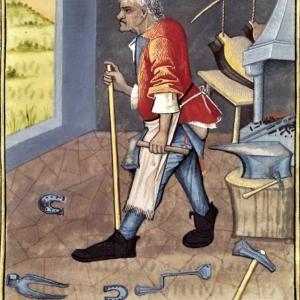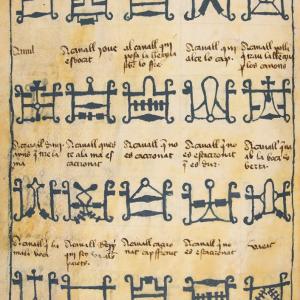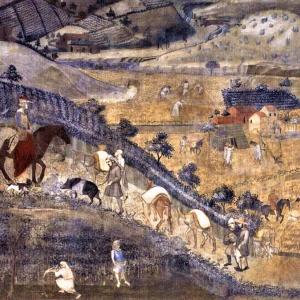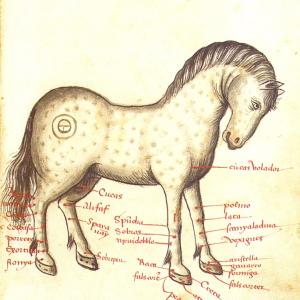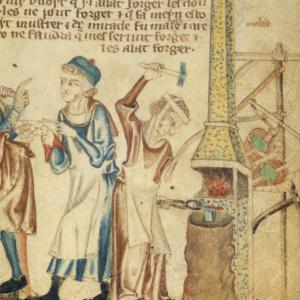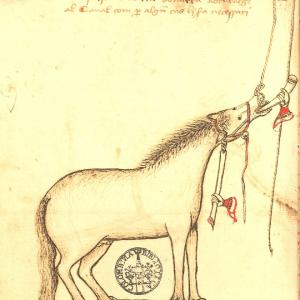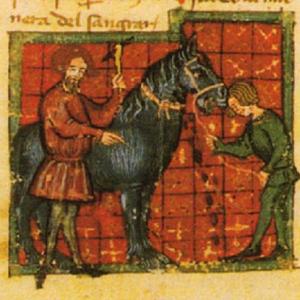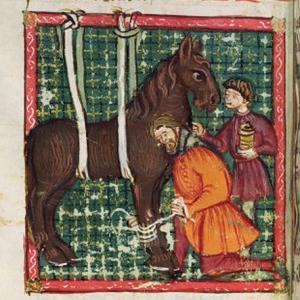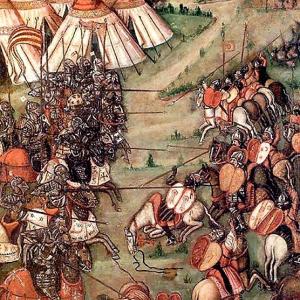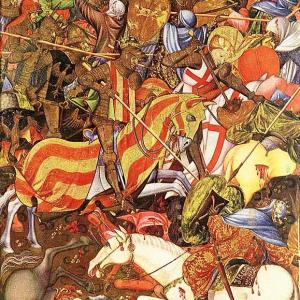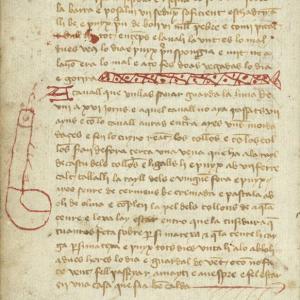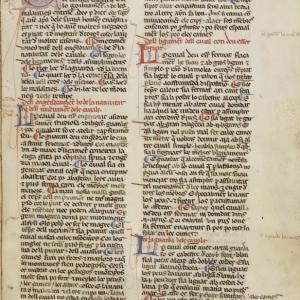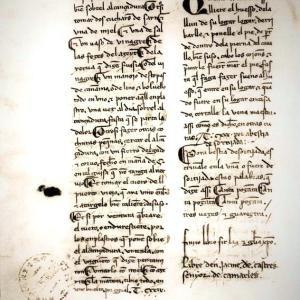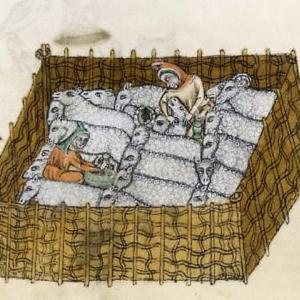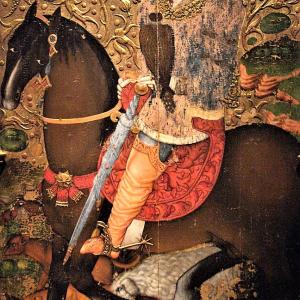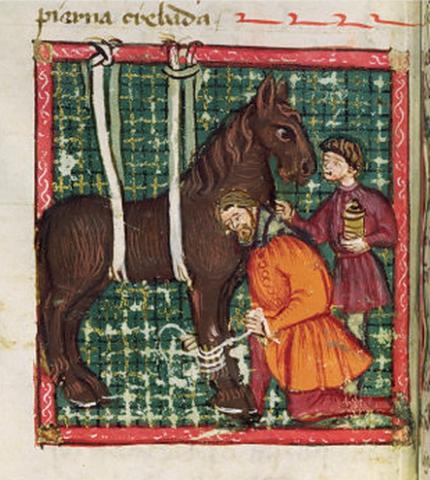
The art of marshalcy and its practitioners in the late Middle Ages
The origins of medieval marshalcy (horse doctoring, old Catalan menescalia) are to be found in the farriers, or blacksmiths, who with their empirically based medical knowledge became increasingly specialized in looking after horses and mules. This led to them being held in high esteem among certain sectors of society, especially in the towns and cities (fig. 1). The duties of farriers and marshals (ferrer and menescal) became mixed up in the late Middle Ages because both groups shoed horses and treated their diseases. Catalan-aragonese scribes used either of these terms and even used the words in combination: farrier-marshal (ferrer-menescal). As happened with the change from barber to barber-surgeon, the incorporation of the term “marshal” was synonymous with economic and social progress. This was achieved, among other things, through access to the books translated into Catalan that were circulating in large numbers during the late medieval period and which enabled them to learn the theoretical aspects of their “art” or occupation.
The similarity between the activities of blacksmiths and marshals can be seen in other ways, for instance the fact that for centuries they were members of the same confraternities and guilds, they gained access jointly to municipal councils and they coincided in the pathways of learning according to the “open system”, through afermament (apprenticeship) with a master. In this respect, the technical sides of their jobs were similar, fundamental for the good use and health of horses and mules, such as fitting horseshoes and bridles, very varied and complex elements (fig. 2), a job also done by bridle makers (freners). For this reason these tasks were described in the marshalcy treatises of the period, as they were essential for the correct movement of the horse, but also because they had therapeutic applications, above all when correcting certain natural defects of horses and mules.
The surviving sources indicate that during the Middle Ages marshals devoted themselves exclusively to healing equines. However, this may be a problem of documentary visibility, and the fact should not be ruled out that, in some circumstances at least, they treated other animals as well, using the theoretical and practical principles of marshalcy, as can definitely be confirmed in the modern period. In urban contexts, marshals most probably worked exclusively with horses and mules, easily the most valuable animals in monetary terms, and in the countryside they also treated the animals used for working in the fields and farming. In the towns and cities they would have more than enough work with the equines circulating every day; in the countryside, treating other animals, more numerous but less lucrative, must have been especially profitable, even though owners tended to be more reluctant to pay for their medical treatment and often preferred to change them rapidly for other animals (fig. 3).
The activities of marshals were in fact very varied, from choosing the animals, breaking them in (in this case, the specialists were called picadors), bridling them, shoeing them, metalwork in general, buying and selling animals, treating horses’ diseases and looking after their health (fig. 4).
Appreciation of marshalcy and its practitioners grew, and trust in and recourse to marshals became increasingly evident, as they were considered to be experts in possession of the appropriate intellectual and practical knowledge (the "art of marshalcy”, art de la menescalia), capable of curing animals’ health problems, improving their condition and ensuring their survival. For a society that valued horses and mules so much, a key aspect of the welfare of humans, they became highly esteemed individuals. Their expertise made it possible, for example, to establish, through reports requested by the judicial authorities, the presence of fraudulent sales of animals with hidden diseases, or of deliberate mistreatment.
Many municipalities, especially middle-ranking ones, decided to hire the services of marshals to look after the local people’s animals. Well known in this respect are the constant agreements between marshals and municipal authorities in the Kingdom of Valencia from the middle of the fourteenth century onwards, for instance in Castelló de la Plana and Vila-real, and during the fifteenth century, as in Alzira and Elx.
A long history of this dedication to medical care meant that Muslims were particularly prominent in the Crown of Aragon, especially in the Kingdom of Valencia. Their skill and fame was such that every king made use of the services of Muslim marshals, belonging to two families in particular, Bellvís and Abenxoha. On the other hand, Jews do not seem to have worked in marshalcy at all and I have never been able to record any working as marshals. The records consulted seem to indicate that women, who worked as doctors and surgeons or ran apothecaries, did not perform any tasks in the field of animal medicine, although this option should not be ruled out (fig. 5).
The theoretical framework of marshalcy can be clearly identified with Galenism, on which the prevailing university medicine was based during the Middle Ages, and with the Aristotelian natural philosophy that framed it and gave it the consistency of a scientia. Diseases could be diagnosed with this paradigm; that is, their causes could be ascertained and treatment offered for them. This is because, as a preliminary step, it helped to understand the body and its workings. The theoretical framework was thus based on the elements, the complexions and the humours, and, more to the point, on natural, non-natural and contranatural things, the chief components of that medical doctrine. This identity of doctrinal suppositions can be clearly seen in the treatises on marshalcy (figs. 2, 4, 6, 11-13), which accept the comparative identity of human and animal diseases, and in many prescriptions, which are declared valid for both humans and animals alike. Therefore, in certain circumstances, marshals were able to treat humans, and doctors, animals.
However, the complex conceptual framework in which medieval doctors operated in order to establish their diagnoses and prognoses and situate therapeutic action was not available to marshals: they had been unable to study at university because there were no studies associated with their profession available. Furthermore, they did not master Latin and so they could not obtain the knowledge pertaining to scholastic medicine. Even so, depending on their level of initial training, which they consolidated by reading and experience, marshals would to some extent be able to apply, more or less thoroughly, the principles of marshalcy, which came to them in doctrinal and practical texts written in Latin and, increasingly, translated or written directly in the spoken language.
When it came to treating horses, the treatises on marshalcy place the emphasis on the preventive regimen, comprising the food eaten, the place where the animal habitually rests (the stable) and therapeutic bleeding (fig. 7). But, as in the case of people, when the preventive regimen failed and disease appeared, therapeutics made use of three actions, which were applied in this order, successively if necessary: controlling the diet, the use of drugs of animal, vegetable or mineral origin, and surgery.
Shoeing and medicating animals was usually done in the open air, very often in the streets close to the city gates, at and in the vicinity of hostels, and especially in squares, where the houses and workshops of marshals were more often than not located. This preference can be explained because squares were where transactions and hiring usually took place, and, logically, a great number of people and animals passed through them. They were where notary’s offices, town halls and churches could be found. Squares were the place for socializing, where everyone went and met for the most diverse reasons. For marshals, as for other professions, having their workshop in a square offered incomparable possibilities, in terms of publicity and clientele.
Marshals worked in the street in front of the workshop. A sort of awning that was stretched over two poles stuck into the wall of the building served to provide shade and protect the customers, the animals, the marshals themselves and the assistants or apprentices they usually had while they were working there. Working in view of everybody attracted customers, and the usual gloom inside buildings, poorly lit with oil lamps or wax candles, made it necessary to work outside. There was also the need for space and the renewal of the air, constantly foul – according to Galenist doctrine – because of the excrement, the urine and the blood on the floor after bleeding. In the increasingly medicalized cities, however, this way of looking after horses and mules led to alarming situations from the sanitary point of view, and the authorities, who were implementing the first urban cleansing policies to be seen in Europe since Antiquity, began to take steps to avoid this “environmental pollution”.
Depending on the customer, the value of the animal and the type of treatment to be performed, marshals had to take into consideration the establishment of a notarial contract, as was the case in human medicine. However, as a general rule, customers had to go directly to the marshals’ workshops, where they would do what was necessary for the animal’s health. Payment would be made in full in cash, even though it was almost certainly also made in instalments, given the importance in the period of small loans in all kinds of transactions.
Afermament (apprenticeship) was the contractual mechanism by which knowledge of the craft professions was acquired, thanks to its transmission by masters to their young assistants, apprentices or afermats (figs. 6-8). These children and young adults, aged between six and 20 approximately, left their family’s home to move into the house of a patron where they would live for a period that varied depending on the trade, the essential minimum for acquiring the necessary knowledge and being able to set up on their own. We do not know what role marshalcy handbooks played in this process, but the possession of specialist books by marshals is well recorded. These handbooks were often written by noblemen (fig. 15), very interested in everything to do with horses, but some marshals also wrote them.
As happened with human medicine, a process began of the filtering and control of the practitioners of marshalcy through examinations and the issuing of licenses by the municipal authorities, which began in the city of Valencia in 1436 – a century after the system had been introduced for medical practitioners – and was in force until the Bourbon Decree of Nueva Planta (1707).
Marshals where much in evidence at royal and noble courts, where they became necessary due to the constant itinerancy of the former and the permanent participation of both in warfare, in which the cavalry played a key part (figs. 9-10). In accordance with the Ordinacions de la Cort (‘Court Ordinances’) of King Peter III the Ceremonious (1344), based on the Leges palatinae (‘Palace Laws’) of the Kingdom of Majorca (1337), marshals were part of the host of officials who, under the overall command of the equerry, had to look after (pensar) the horses and the royal stables, in particular the conditioning, the feeding and the treatment of the sick (afollades) animals.
In the royal Ordinacions, along with the duties of shoeing and curing, marshals were assigned those of training, breaking in and bridling the animals. For this they were paid a salary (quitació), besides other supplements, especially in wartime, when they had to accompany the army, along with their assistants and the appropriate equipment. Before the campaign started, the marshal had to estimate (estimar) the value of the animals accompanying the army (steeds, nags and mules). When one of the animals transporting the members of the expedition was wounded (fig. 10) or fell ill, its owner had to be compensated (esmenat), according to the animal’s estimated value, which had been recorded in a book where the qualities and aptitudes of the animal and its final value were specified. This system of compensation and functioning designed by the royal household was copied meticulously by the nobility.
Marshals were not the only people who looked after animals. The nature of their work forced them to use assistants, and so there were often lads and slaves in the workshops, who helped with the handling of the animals and thus enabled their masters to take on more customers. Some slaves had such mastery of marshalcy that they gained the confidence of the royal household (figs. 6-8).
In the case of those for whom the horse was the essential tool of their work it became especially important to possess the basic knowledge to enable them to take care of it, especially in time of war, when there were not usually enough marshals accompanying the army to look after all the wounded horses. The authors of books on marshalcy (like Manuel Díez, the author of one of the most outstanding treatises on marshalcy that circulated in the territories of the old Crown of Aragon), the legal codes and the works of literature, said that every good knight ought to know the rudiments of marshalcy (figs. 4 and 6).
On the other hand, many people could not afford to go to the marshal when their horses and draught animals fell sick and they had to look after them with prescriptions included in family books, put together thanks to the empiricism handed down from generation to generation. These collections of recipes tell us of the social penetration of the knowledge and the interest in the art of marshalcy.
For all these reasons the practice of menescalia and the act of menescalcir – looking after the animal’s health – transcended the horse doctoring profession and appeared in works of literature, such as Jaume Roig’s Espill (‘Mirror’), or lessons in chivalry, like the Llibre de l’orde de cavalleria (‘Book of the Order of Chivalry’) by Raymond Lull.
Secondary literature (on the Catalan context)
- Ll. Cifuentes, “Cavalls, bous i vaques: sobre manescalia i agronomia a Catalunya entre l'Edat Mitjana i la Moderna”, in J. Batlló, P. Bernat and R. Puig (coord.), Actes de la VI Trobada d'Història de la Ciència i de la Tècnica (Vic, 27, 28 i 29 d'octubre de 2000), Barcelona, Societat Catalana d'Història de la Ciència i de la Tècnica, filial de l'Institut d'Estudis Catalans, 2002, pp. 87-91
- Ll. Cifuentes, La ciència en català a l'Edat Mitjana i el Renaixement, Barcelona - Palma, Universitat de Barcelona - Universitat de les Illes Balears, 2002 (2nd rev. and enl. ed.: 2006)
- Ll. Cifuentes, C. Ferragud and Ll. Garcia Ballester, “Els menescals i l'art de la menescalia a la Corona d'Aragó durant la Baixa Edat Mitjana”, in Història de la ramaderia i la veterinària als Països Catalans [=IV Col·loqui d'Història Agrària (maig del 1997)], Barcelona, Universitat de Barcelona: Centre d'Estudis d'Història Rural, 1999, pp. 75-98
- Ll. Cifuentes and C. Ferragud, “El Libre de la menescalia de Manuel Dies: de espejo de caballeros a manual de albéitares”, Asclepio, 51 (1999), 93-127
- M. Cordero del Campillo, “Veterinary medicine in the medieval period: the Christian kingdoms in Spain”, Historiae Medicinae Veterinariae, 22 (1997), 73-96
- V. Dualde Pérez, Historia de la albeytería valenciana, Valencia, Ajuntament de València, 1997
- C. Ferragud, La cura dels animals: menescals i menescalia a la València medieval, Catarroja, Afers, 2009
- M. Grau Montserrat, “Medicina a Besalú (s. XIV) (metges, apotecaris i manescals)”, Annals 1982-1983 [del Patronat d'Estudis Històrics d'Olot i Comarca], 5 (1982-1983 [=1984]), 101-133
- Y. Poulle-Drieux, “L'hippiatrie dans l'Occident latin du XIII e au XV e siècle”, in G. Beaujouan, Y. Poulle-Drieux and J.-M. Dureau-Lapeyssonnie, Médecine humaine et vétérinaire à la fin du Moyen Âge, Geneva - Paris, Droz - Minard, 1966, pp. 9-167
- B. Prévot and B. Ribémont, Le cheval en France au Moyen Âge. Sa place dans le monde médiéval; sa médecine: l'exemple d'un traité vétérinaire du XIVe siècle, la Cirurgie des chevaux, Orléans - Caen, Paradigme, 1994
- Á. Sánchez Gozalbo, “La sanidad en el Castellón trecentista (veterinarios, médicos y boticarios)”, Boletín de la Sociedad Castellonense de Cultura, 48 (1972), 246-274.
- C. Sanz Egaña, Historia de la veterinaria española: albeitería, mariscalería, veterinaria, Madrid, Espasa-Calpe, 1941
- A. de Vilanova, Regimen Almarie (Regimen castra sequentium), ed. Michael R. McVaugh and Lluís Cifuentes, Barcelona, Fundació Noguera - Universitat de Barcelona (Arnaldi de Villanova Opera Medica Omnia, X.2), 1998
Editions of Catalan primary sources
- M. Batllori, "Un llibre de manescalia en català a la Biblioteca Universitària de Bolonya", Anuari de l'Oficina Romànica de Lingüística i Literatura, 5 (1932), 179-223 [repr. in: Obra Completa, vol. 1 (De l'Edat Mitjana), Valencia, Tres i Quatre, 1993, pp. 217-265]
- Ll. Faraudo de Saint-Germain, “El texto primitivo inédito del Tractat de les mules de Mossen Dieç”, Boletín de la Real Academia de Buenas Letras, 23-24 (1950-1952), 9-48
- J. Gili (ed.), Lo cavall: tractat de manescalia del segle XV, Oxford, The Dolphin Book, 1985
- J. Gili (ed.), Libre dels cavayls que compós Ypocras: manuscrit del segle XV, Oxford, The Dolphin Book, 1988
- H. Menhardt, "Pharmacologie catalane: un manuscrit catalan dans la bibliothèque de l'êveque à Klagenfurt-Autriche", Anuari de l'Oficina Romànica de Lingüística i Literatura, 3 (1930), 245-267
- F. Viñas i Serra, "Un libro inédito de veterinaria y equitación", Revista de Gerona, 10, year XI (1886), pp. 142-150
A historical and dialectal Catalan dictionary, which includes a good selection of technical vocabulary of medieval and modern marshalcy.
Project for the computerization of the glossaries of the meritorious editions by L. Faraudo de Saint-Germain.
Descriptions of manuscripts and printed editions in Catalan, information about the works and their authors, and technical vocabulary.
Descriptions of manuscripts and printed editions in Catalan.
Blog of the Associació Catalana d'Història de la Veterinària (ACHV).
1) menescal, albéitar, hipiatra, veterinary doctor
In the Middle Ages, marshals looked after the health of equines and, by extension, other solid-hoofed animals, applying the knowledge pertaining to the discipline known traditionally as the “art of marshalcy”. These men, however, were not always called this. The classical Greek word, in both the Greco-Roman and the Byzantine worlds, was hippiatros (horse doctor), a practitioner of the science known as hipiatria (horse doctoring), as equines were the only animals looked after by them. Caring for the health of animals in flocks and herds may possibly have been the job of shepherds (fig. 14), as has been recorded in later periods. In the Roman army there was the veterinarius, the soldier who looked after all the animals used in the military context for any reason (war, carriage, food or sacrifice).
In the medieval West, the only exception being the centre and west of the Iberian Peninsula, the word menescal spread. This word comes from the Frankish marhskalk, ‘he who looks after horses’ (marh = horse, skalk = he who looks after, he who serves), in the sense of being responsible for them, which we could translate as equerry. Among the Germanic peoples in the early Middle Ages he was a military chieftain in command of, and responsible for, a dozen horses, and even though at times he could work as a veterinary doctor he usually had assistants to help when dispensing medical care to those animals. This dual role, military and veterinary, was to determine the uses of the words that derived from it: in Catalan, mariscal and menescal (or manescal), in French maréchal and maréchal-ferrant, in Italian marescallo and maniscalco, in English marshal, in German marstall. In early modern Spain, the world mariscal was used to refer to high-ranking soldiers, but also army vets.
However, in Castile and Portugal, more influenced by Islamic culture, the use of albéitar spread (from the Arabic al-baytar, horse doctor) to refer to marshals, and this is how it appears in the Partidas of King Alfonso X the Wise. Moreover, one must bear in mind that Latinizations of the words with which these practices are identified are habitual in medieval documents (menescallus, faber, faber menescallus). The medieval names continued in use until the development of contemporary professionalization and the appearance of schools and faculties of veterinary science at the end of the early modern period, and above all in the early decades of the nineteenth century. Ever since then "veterinary doctor" has prevailed, Roman in origin and which was used to refer to a range of activities that went far beyond horses.
2) menescal / manescal, menescalia / manescalia
Despite the etymology and the recommendations of modern Catalan dictionaries (manescal, manascalia), we choose to spell these words with ‘e’ in the first syllable, because (1) this is the form used in the texts written by individuals with superior writing and grammatical skills (the official documentation, in particular that of the Catalan-aragonese Royal Chancellery, and the most carefully produced copies of the technical handbooks in the discipline in Catalan, even the printed Barcelona editions of 1515 and 1523 of Manuel Díez’s work), where the exception is always the form with ‘a’; and (2), very especially, because it is the one that has survived in western Catalan forms of speech. The form with ‘a’ is mostly late, a product of the phonetic confusion between ‘a’ and ‘e’ typical of eastern Catalan forms of speech, and it appears above all in less important texts (often prescriptions or miscellaneous annotations), written by individuals with limited writing and grammatical skills. When compiling the first normative dictionaries of Catalan (Fabra), the western forms of speech were too overlooked and linguistic researchers did not have proper knowledge of either the documents or the surviving manuscripts (Coromines’ reasoning is eloquent).
1. A farrier (blacksmith) in his workshop, wearing the typical clothes and surrounded by all his tools. Depiction of Vulcan, in Évrard de Conty, Échecs amoureux. Paris, Bibliothèque nationale de France, MS Fr. 143, f. 148r (c. 1496-1498).
2. Bridles designed to correct the bad habits of horses. Giordano Ruffo, Llibre de menescalia de cavalls. Oxford, Private collection of Joan Gili (15th C).
3. Movement of animals entering and leaving the city. Ambrogio Lorenzetti, Effetti del buon governo in campagna. Siena, Palazzo Pubblico, Sala dei Nove (1338-1340).
4. Diseases of the horse’s legs. Manuel Díez, Llibre de la menescalia. Barcelona, Biblioteca de Catalunya, MS 1661, f. 7r. (1502).
5. Woman working in a forge. Holkham Bible. London, British Library, MS Add. 47682 (2nd quarter of the 14th C).
6. Way of administering beverages to the horse. Manuel Díez, Llibre de la menescalia. Seville, Biblioteca Colombina, MS 5-4-46, f. 7v (mid 15th C).
7. Bleeding a horse. Juan Álvarez de Salamiellas, Libro de menescalcía et de albeytería et de física de las bestias. Paris. Bibliothèque nationale de France, MS Esp. 214, f. 28v (c. 1390).
8. A marshal with his assistant. Juan Álvarez de Salamiellas, Libro de menescalcía et de albeytería et de física de las bestias. Paris. Bibliothèque nationale de France, MS Esp. 214 (c. 1390).
9. Cavalry forces in combat. Battle of Llutxent. Altarpiece of the Corporales in Daroca. Daroca, Museo de la Colegial de Daroca (15th C).
10. Horses wounded in battle. Battle of El Puig. Marçal de Sax, Altarpiece of Saint George or of the Centenar de la Ploma. London, Victoria & Albert Museum (1405).
11. Instructions for healing or castrating a horse in a Catalan marshalcy handbook. Barcelona, Arxiu Històric de la Ciutat de Barcelona, MS A-49 (14-15th C).
12. Cirurgia dels cavalls (‘Horse Surgery’), Catalan translation of the treatise by Giordano Ruffo, royal MS. Paris, Bibliothèque nationale de France, MS Esp. 212 (mid 14th C).
13. Libro de los caballos (‘Book of Horses’) in Castilian, copy owned by Jaume de Castres, lord of Camarles. Perpignan, Médiathèque de Perpignan, MS 28 (14-15th C).
14. A shepherd administering a medicine to a sheep. Luttrell Psalter. London, British Library, MS Add. 42130 (c. 1335-1340).
15. A knight with a falcon and a pack of hounds. Jaume Ferrer II, Saint Julian, in the Altarpiece of Saint Julian in Aspa. Lleida, Museu de Lleida (mid 15th C).
Translated by Andrew Stacey, 16/11/2017
